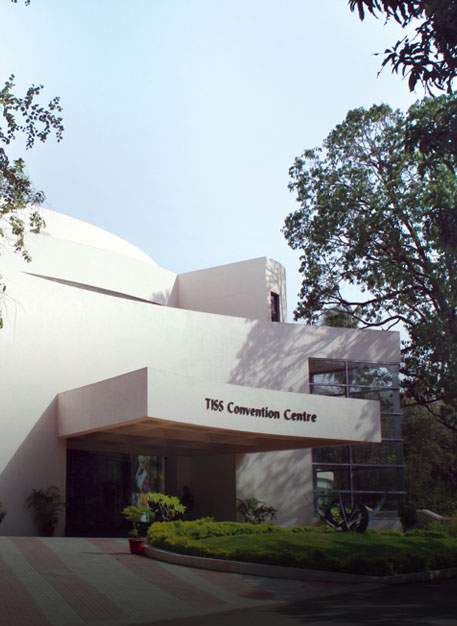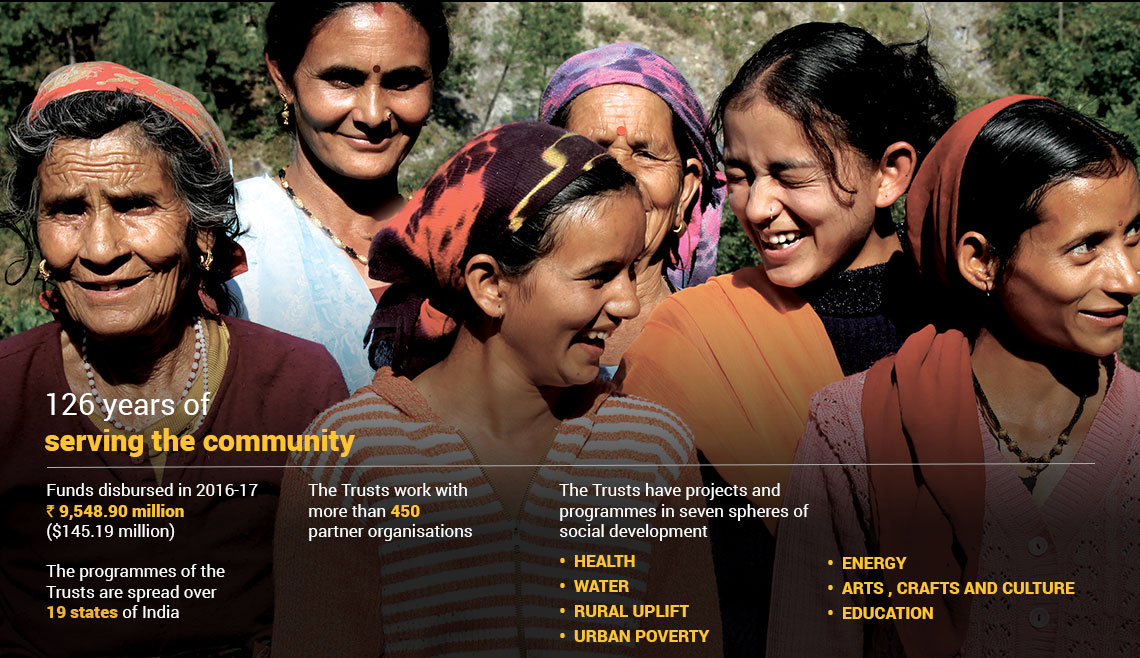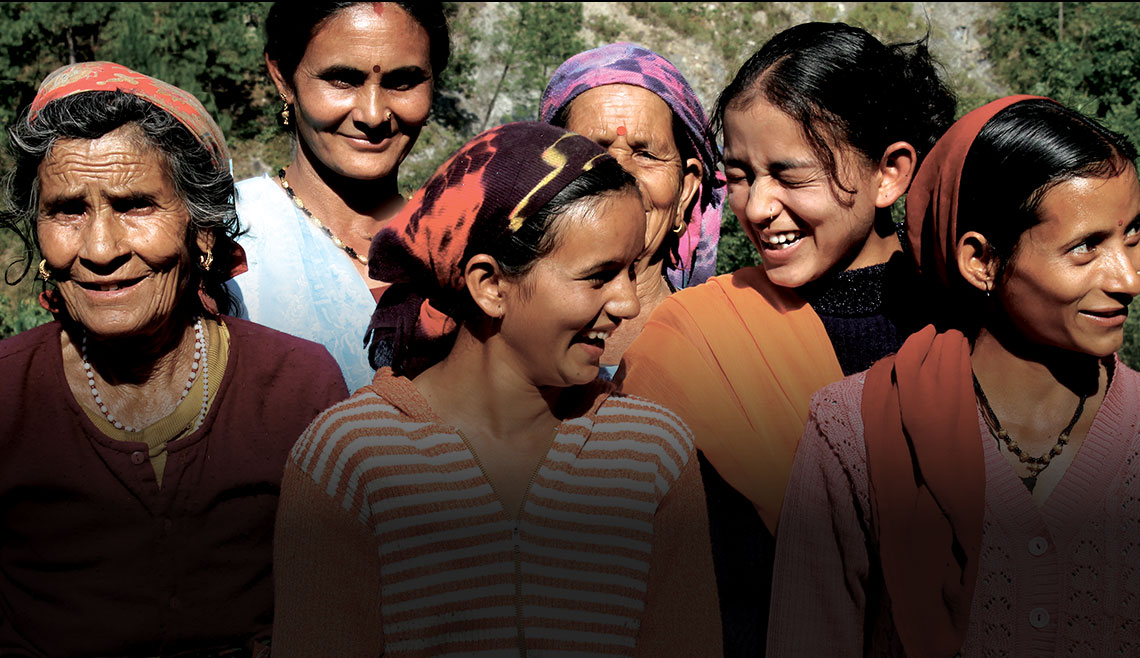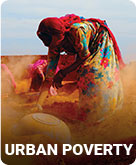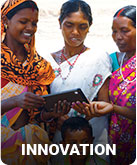The renewal and after
The Tata Trusts have stayed true to the legacy of their founders while deepening and spreading the impact of their numerous programmes
The essence of what the Tata Trusts do to enhance the lives of those who need a helping hand has remained unchanged for more than a century and a quarter, but there has been a transformation undertaken over the past four years to deepen and to spread the impact of the collective institution’s countless initiatives.
The renewal has provided fresh impetus to the mission of the Trusts — to improve the quality of life of those they touch, especially the poor and deprived. That has been the rationale nourished by the Trusts ever since the first of them, the JN Tata Endowment for the Higher Education of Indians, was established in 1892 by Tata group Founder Jamsetji Tata. In the 126 years since, the Tata Trusts have earned recognition for the causes they support.
The Tata Trusts comprise individual trusts that have been set up over time. Together, they hold two-thirds of the shares of Tata Sons, the promoter and holding company of the Tata group. The wealth that accrues from this asset is employed to fund a range of social and community development programmes in seven spheres.
The combined efforts of the Tata Trusts make for an extraordinary saga of philanthropy — one that has enriched India and its citizens in multiple ways.
Changing for impact
This has stayed constant even as the Trusts have evolved to ensure that their initiatives and interventions are relevant to changing times.
Through direct involvement with projects; partnerships with NGOs, government institutions and global agencies; and a sharper focus on ground-level results; the Tata Trusts have over the recent past enhanced the impact of their philanthropic endeavours.
The intent of the Trusts has been translated into impact in the field. Spread over 19 states across the country — and with the help of more than 450 partner organisations — programmes and projects backed by the Tata Trusts have reached millions of Indian households.
There are seven thematic areas and two platforms in the cluster-based structure that the Tata Trusts have adopted to enhance the impact of the more than 1,000 development programmes that they are involved with across India. The seven thematic areas are: healthcare; water; rural uplift; urban poverty; energy; arts, crafts and culture; and education. Innovations and institutions are the two platforms that the Tata Trusts employ.
The new approach of the Tata Trusts is guided by the principles of tangible impact, scale, institutional sustainability, direct engagement with communities and social entrepreneurship. Flowing from these principles is the mission statement of the Trusts — ‘To impact a 100 million lives by 2021’.
The Tata Trusts’ vision is another clear indicator of their intent: ‘To be at the forefront of nation building by not just propping up the weakest and most helpless members, but also lifting up the best and the most gifted.’
- Healthcare
- Water
- Energy
- Rural uplift
- Urban poverty
- Arts, crafts and culture
- Education
- Innovation
- Institutions
The healthcare challenge confronting India is cause for growing concern. The low socioeconomic status of Indians stricken with illness is compounded by issues such as access and affordability.
The Tata Trusts have focused attention on some of the most pressing health crises affecting the country, among them cancer, tuberculosis, malaria, and infant and maternal health. They have supplemented their efforts through an integrated approach that includes a layering of educational and livelihood initiatives to enable rural and semi-urban communities to make the right choices when dealing with health issues.
The Trusts have developed an array of specific healthcare solutions to reach out to and address the needs of distressed communities in different parts of the country. A standout initiative concerns cancer, a crippling problem for a nation battling poverty and illiteracy.
The Trusts are investing continually in building institutions of excellence for cancer care, creating information networks and providing access to modern equipment. The endeavour is to create a network of care and cure for the millions of Indians affected by cancer.
Healing the community
As with cancer, the Trusts’ work in tuberculosis and malaria helps heal communities and families. This is being done through an innovative combination of institutional care, easy access to drugs, behavioural interventions, dedicated experts and a global platform that enables partnerships for solutions.
Infant mortality and maternal health is another health priority. Also, and in particular, the Tata Trusts have chosen nutrition as a cause. The focus population groups are infants, pregnant and lactating mothers, and school-going children.
The Trusts are working on several healthcare fronts and have collaborations with the National Institute of Nutrition, Hyderabad, and the Food Safety and Standards Authority of India.
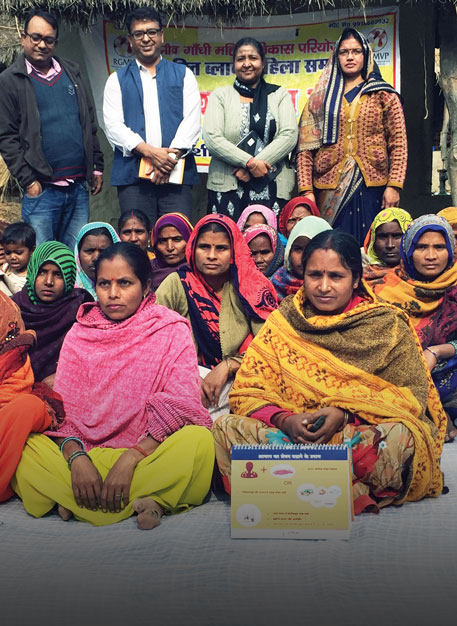
More than half of India’s 1.3 billion people live not only in poverty but also in water-stressed conditions — and that’s no coincidence. It gets worse: 34% of India’s water resources are contaminated by microbiological waste and heavy metals and 21% of diseases in India are water-related.
The Tata Water Mission is an integrated programme that combines interventions in water, sanitation and hygiene.
The Mission’s target is “to give better access to pure water to 6 million people in 7,000 villages across 12 states within the next three years”. About 3,000 villages have been covered under the Mission, which is active in Gujarat, Uttarakhand, Rajasthan, Karnataka, Telangana, Andhra Pradesh, Odisha, Jharkhand, Nagaland and Assam.
The Mission plays an important role in improving sanitation for rural communities. In 2016, it took on the role of development support partner to the Indian government’s Swachh Bharat Mission (SBM), which has a deadline of October 2019 to end open defecation in the country.
In 2016-17, the Tata Trusts partnered the government for SBM in 35 districts. At the government’s request, the Trusts started the Zila Swachh Bharat Prerak initiative to train 600 people to assist district administrations in meeting targets.
The mission to improve the lives of millions of Indians is a tough challenge. The Trusts are using the traditional strengths of community mobilisation and the power of innovative models and technology to deliver on a scale never attempted before.
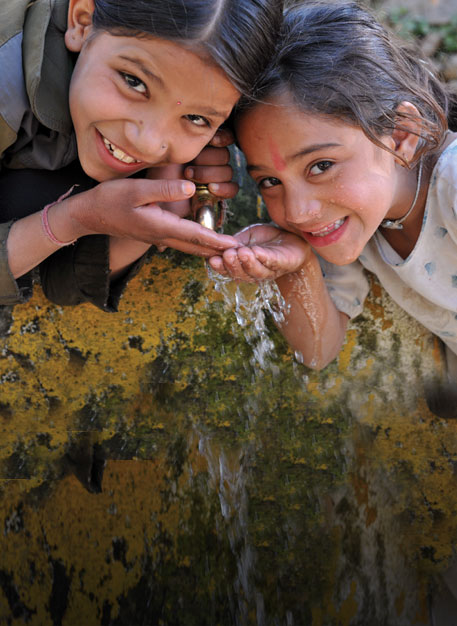
Access to energy is an essential ingredient in shaping the quality of life of communities, especially in rural India. The Tata Trusts work on energy solutions to serve communities by targeting improvements in livelihoods, health, education, environment and access to water.
A startling 87% of rural India uses solid fuels for cooking, 800 million Indians are affected by household air pollution and 1.25 million Indians are killed by household air pollution every year. The energy programme looks at clean cooking for rural and tribal communities, solar energy for household electrification, and improvements in irrigation.
That leads to affordable clean cooking devices, solutions that light up the lives of people in places without electricity and solar energy that allows farmers to irrigate fields. The clean cooking initiative and alternative energy are vital from the Trusts’ perspective.
The Trusts have partnered the International Water Management Institute to set up a solar cooperative where farmers can sell excess energy and use solar energy to generate income. They have also used the collaborative approach to get quality solar lanterns and systems to households in Rajasthan and Odisha.
The solar energy space has been built on partnerships with the Massachusetts Institute of Technology, the Indian Institute of Technology Bombay, nonprofits and social sector entities. The idea is to help bring some light to the lives of Indians without a reliable and continuous source of power.
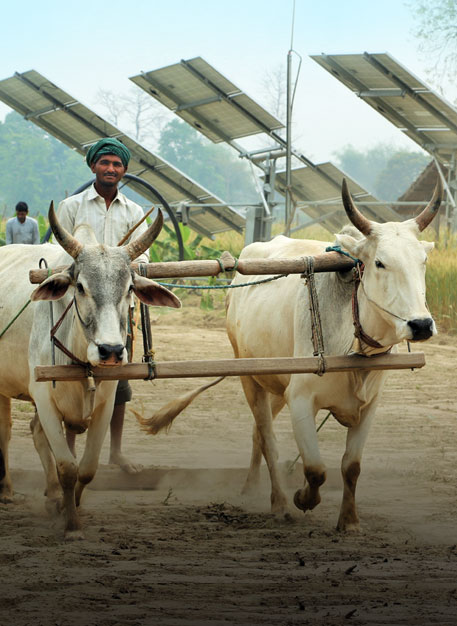
Agriculture is critical to the well-being of any nation. This is especially true in India, not just because it contributes 16 percent to the country’s GDP but also because more than half of the Indian populace depends on it.
Poor crop yields, low agricultural incomes and small land holdings are among the reasons why most of those who farm for a living are in a sorry state. The Tata Trusts are striving to make a difference by getting to the root of the issue. Sustainable development of marginalised communities is a focus area under the Trusts’ rural uplift portfolio.
A mix of interventions
Projects supported by the Trusts encompass sustainable natural resource management, agriculture, water and sanitation, micro-finance, rural entrepreneurship, and business development.
The Trusts have end-to-end projects allied to agriculture, with production and the organising of communities around that, creating structures, linking them to markets, and developing value chains.
The Trusts’ Central India Initiative focuses on tribal communities. Important in the context is their mission programme, Lakhpati Kisan — Smart Village, which aims to bring out of poverty 101,000 households in four Indian states, and in a manner that is irreversible.

By 2030, an estimated 40% of India’s population will be living in metropolitan areas. In a rapidly urbanising country, poverty in cities is growing in scale as well as complexity. To make matters worse, this is a space that is little understood or much ventured into.
It was in response to this situation that the Tata Trusts added urban poverty to their portfolio in 2006. The programme, now in its second phase, has three sub-themes: migration, skills and habitat.
The broad purpose of the migration project is to look at how to reduce the vulnerability of migrants and ensure that migration becomes a successful livelihood strategy for them.
Focus on migrants
The Trusts’ focus in the first phase was on supporting migrants through resource centres that provided them with identity cards, information on government schemes, etc. In the second phase, the project tracks migrants and the places that they journey to.
The Trusts have an initiative that aims to provide the urban poor with skills required in the informal sector. The habitat initiative looks to help poor communities in urban India gain access to housing, basic services and livelihoods. In the pipeline are projects connected to affordable housing design and the delivery of basic services. There is also a focus on making India’s cities safer for kids.
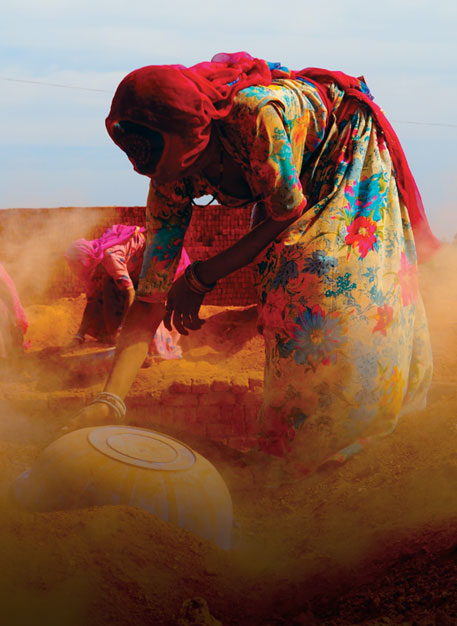
India has a rich heritage of arts, crafts and culture that has evolved with its long and varied history. However, apathy and neglect have resulted in the slow death of ancient art forms and in artisans drifting away from their craft. The arts, crafts and culture portfolio of the Tata Trusts was set up to help conserve India’s tangible and intangible heritage and foster sustainable livelihoods for artists and artisans.
The Trusts are involved in the conservation of built heritage, and also art conservation. This is an urgent need in India, where several artefacts and museums are deteriorating and there is a shortage of trained conservators to look after them.
Support for courses in art conservation, film restoration and contemporary dance; digitisation of cultural texts and records; music education for poor children and communities; creation of cinema study capsules; exhibitions on architecture and housing; and a platform that encourages dialogue between stakeholders in the arts — these are some of the interventions that reflect the shift in the Tata Trusts’ focus.
Efforts are also underway to make craft-based livelihoods respectable and lucrative. What has been shown to work is the independent entrepreneur model, where individuals are not dependent on any organisation or medium to earn their livelihood. Initiatives in reviving craft-based livelihoods include projects on natural fibre-based products in Manipur and dhokra metalware in Odisha, the pre-loom network in Andhra Pradesh and entrepreneurial training of young handloom weavers in Madhya Pradesh.
By bringing in technology skills for conservation, digitisation and capability building, the Trusts are attempting to preserve the vast pool of practices and pursuits that illuminate the country’s culture and heritage. Kalapana and Tata Trusts Art Archives are the two platforms that have been formed by the Trusts for this purpose.

The initiatives of the Tata Trusts in education are concentrated on ensuring that children and adolescents gain access to quality learning.
The objectives here are to improve the quality of pedagogy by building teacher competence, engage the community, work on research and policy, and on introducing curricular innovations.
The Trusts support and implement projects in villages and districts across 12 Indian states. These are aimed at improving the quality of education from preschool to high schools, bringing dropout adolescents back into the system and driving women’s literacy.
The Trusts have undertaken three thematic initiatives to help plug some of the large gaps in India’s education sector. The Parag project supports educational development and dissemination through children’s books in Indian languages. The Trusts are also working on improving teacher training, with plans for a nodal centre and regional hubs.
Additionally, there are currently three key interventions in the technology and education space: CLIx, or the ‘connected learning initiative’; the ‘integrated technology in education’ project; and a programme to create educational material in Hindi and other Indian languages.
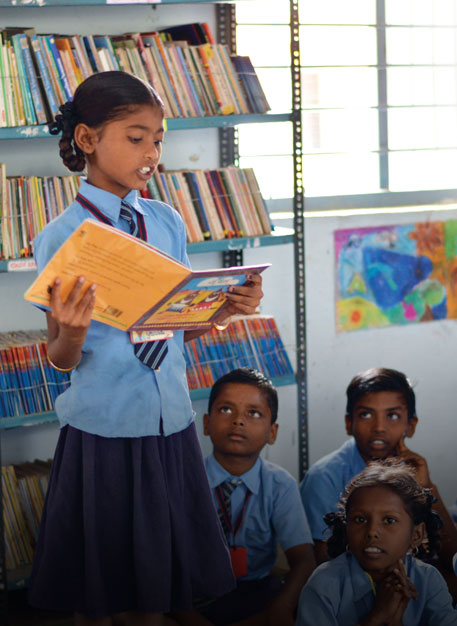
Innovation has the power to harness new technologies to create novel and better solutions that can address developmental challenges. That’s the big reason why it is an important pillar in the design and implementation strategy adopted by the Tata Trusts for their social uplift projects.
Take the example of capacity-building in the Indian government’s Swachh Bharat Mission. The Tata Trusts used virtual classroom technology to connect to people in remote rural regions and villages, using multiple ‘classrooms’ linked to a single studio.
Digital literacy
One of the Trusts’ programmes with technology at its heart is ‘Internet Saathi’, developed in partnership with Google India. Internet saathis (or companions) are rural women trained on smartphones and tablets to be digital guides for rural communities.
Data-driven governance is another technology-driven project, as is the ‘village transformation project’, which combines the strengths of the state government, corporate donors and philanthropic foundations. Social innovation is a powerful tool for change, and the Trusts are enabling this through the Foundation for Innovation and Social Entrepreneurship.
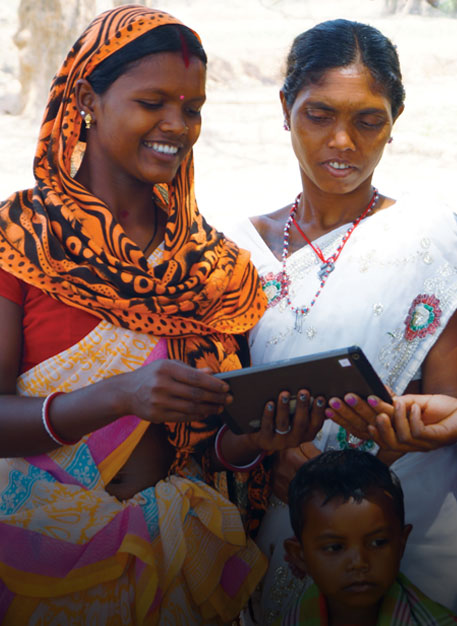
Building institutions of knowledge and ramparts of research has been a hallmark of the Tata Trusts’ work in supporting and enabling the spread of academic excellence in India.
The Trusts’ role in establishing and backing some of the country’s best-known institutions for higher learning has been sustained for more than a century and covers a wide spectrum of disciplines, from the fundamental and social sciences to medicine and the arts.
The first such institution to benefit from the Tata philosophy of philanthropy was the Indian Institute of Science, established in Bengaluru in 1911.
The Tata Institute of Social Sciences, established in Bombay in 1936, has done standout work in social development. The Tata Memorial Centre, set up in Bombay (now Mumbai) in 1941, has become a global benchmark in cancer research and treatment.
The Tata Institute of Fundamental Research, established in 1945 in Bombay, is another remarkable institution. The Tata Medical Center, set up in 2011 in Kolkata, has in a short span of time grown to become a world-class facility, and one that offers treatment free of cost to about half of its patients.
The Tata Trusts have also initiated several collaborations that add to their institutional support roster, including with the Indian Institute of Technology Bombay, the Massachusetts Institute of Technology, Harvard Business School, Cornell University, the University of Chicago and the University of California San Diego.
